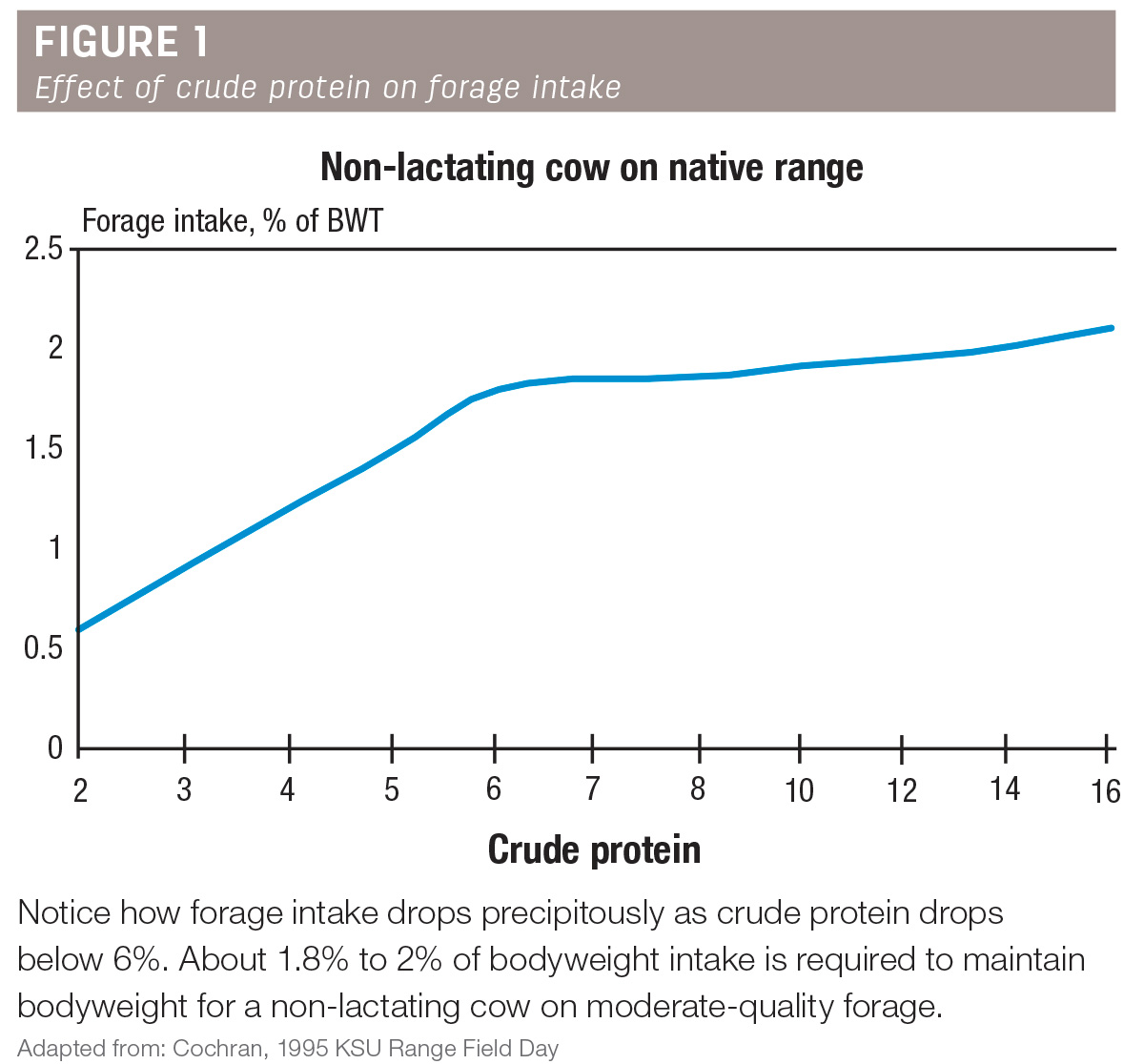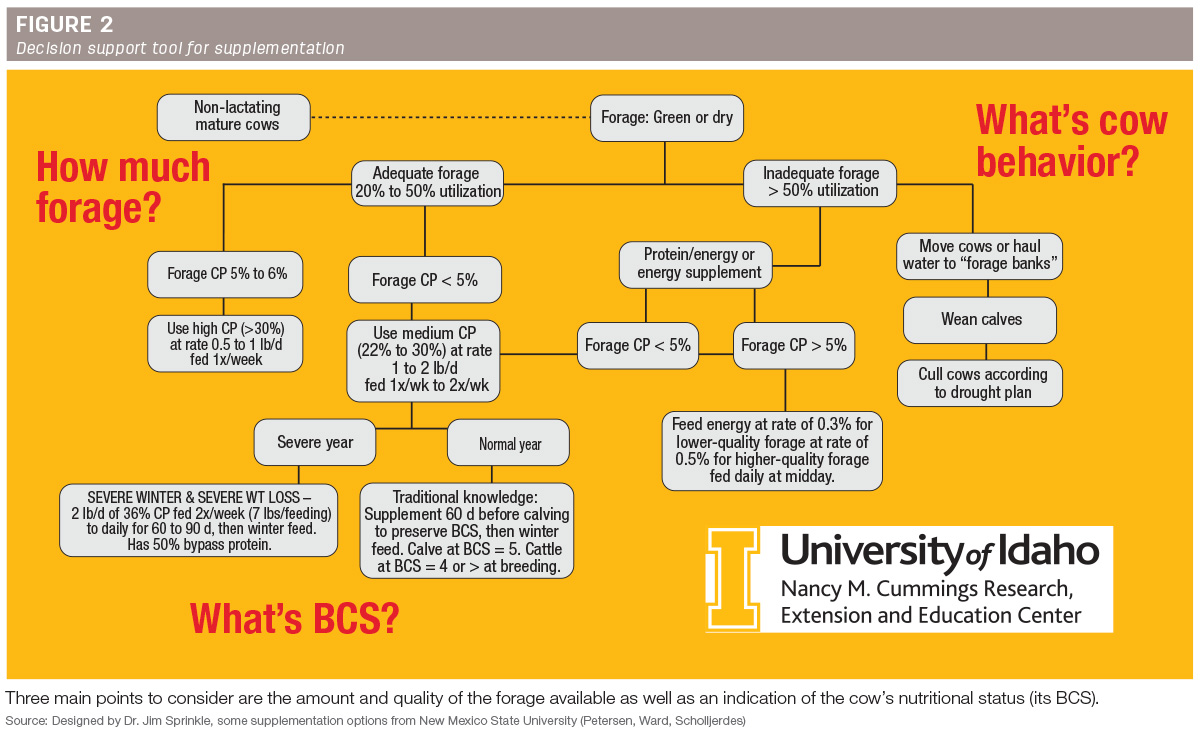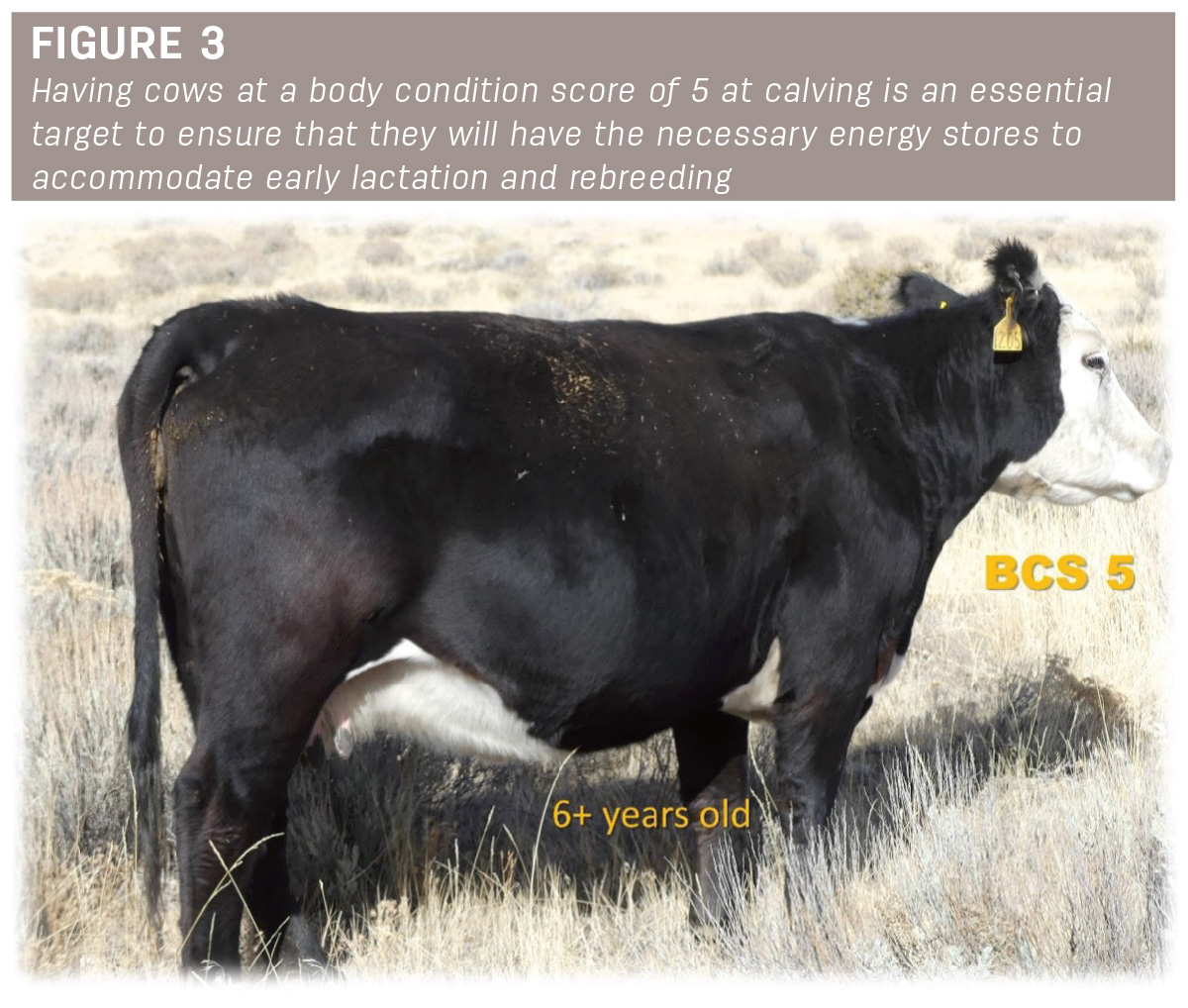Important principles
There are some important principles to consider when designing a supplementation program for cattle grazing late-season dormant forage.
- Feed both the cow and the rumen. Supplemental protein is required when forage is less than 6% to 7% crude protein (CP; Figure 1). Protein that feeds the rumen is degradable intake protein; protein for the cow is undegradable intake protein or bypass protein and some microbial protein.
- Quantity: A range cow needs to have the opportunity to eat all the forage she can every day. If she doesn’t lie down by midmorning, there is a potential problem with forage supply.
- Quality: Supplementing CP will often increase both forage intake (sometimes greater than or equal to 30%) and digestibility (greater than or equal to 15%) on warm-season grasses due to increased rumen microbes and faster passage rate. For cool-season grasses, which are dominant in the Pacific Northwest, the increase in forage intake is more modest (7% greater intake; 5% greater digestibility) due to greater forage quality for cool-season grasses. However, cool-season grasses have about half of the bypass protein as warm-season grasses (15% of total protein for cool-season grasses).
- Protein supplements can be fed in the daily ration (1 to 2 pounds) once or twice a week (7 pounds per feeding), while energy supplements (e.g., corn) must be fed daily. Frequent supplement feeding habituates cattle to the feeding regimen and reduces daily grazing time.
- For severe winters with greater opportunity for weight loss, consider adding 50% bypass protein to your protein supplement to reduce winter stress on the cow herd.
- Body condition score (BCS) 5 is a good target for calving.

As forage ages, the amount of fiber (cellulose and lignin) increases and the CP declines. The harvested forage is more slowly digested by rumen microbes due to the increase of cell wall constituents in the plants. By providing more rumen-degradable protein in the form of a protein supplement, we allow the rumen microbes to increase in population, thus allowing for more microbes to break down and digest the forage into volatile fatty acids (such as acetate), which are absorbed through the rumen and used as an energy source.
Protein supplementation will also speed up the passage rate of the forage from the rumen, allowing the cow to eat more forage to help satisfy maintenance requirements. Some of these rumen microbes will also pass into the lower digestive tract and can be used as a protein source by the cow. Undegradable dietary protein that passes through the rumen without being used by the rumen microbes is referred to as bypass protein and will be digested in the small intestine. When cows are severely stressed by extreme weight loss or harsh winter conditions, bypass protein can be helpful to reduce weight loss.
Providing bypass protein supplies extra amino acids that can be converted into the necessary glucose required to initiate the burn cycle in the liver to turn volatile fatty acids (from the rumen) and free fatty acids (from stored body fat) into energy.

Supplementation strategies
Figure 2 illustrates a decision support tool for choosing a supplementation program for non-lactating cattle. (The decision tool is discussed more fully in a webinar video titled "Strategic Supplementation for Drought and Dormant Season Grazing" available on the University of Idaho Drought Resources for Livestock Producers website). Briefly, if you have an abundance of green forage or adequate forage with greater than 7% CP, no intervention for supplementation to the cow herd is required. Most late fall-irrigated hay meadows with residual forage or rangelands with abundant quality browse (e.g., winterfat) would fit into this category.
Let us assume that you will not be bringing the cow herd to your stockpiled hay meadows until mid-December. If the forage supply is adequate for your late-season rangelands (less than 40% to 50% forage utilization), the next decision to make is whether the CP is 5% to 6% or less than 5%. If CP is less than 5% and the year is somewhat normal, then the suggestion is to provide 1 pound of protein supplement per cow per day but fed once weekly at 7 pounds per cow.
Range cow research over the last 20 years has shown similar performance between cows fed protein supplement daily, two or three times per week and once per week. This works because the breakdown product of excess protein will recycle back into the rumen two or three days after being consumed. If cow weight loss is extreme or if there are many days of inclement weather, then the cow herd should probably receive 2 pounds of protein supplement per day, fed twice a week at 7 pounds per cow.
Figure 2 further shows that if the forage utilization is greater than 50%, then one should consider feeding an energy supplement or combination protein/energy supplement. If an energy supplement is fed, it must be fed daily to avoid issues with rumen acidosis and impaired fiber digestion. For any of these supplements, feeding at midday when cows are typically resting from grazing will reduce the disruption to grazing.

Expected performance
If you receive late-fall rain that greens up forage, you will not need to provide supplement until forage quality drops sharply. In a study done in southeastern Idaho, cows not supplemented in a year with good fall rains and green forage gained 0.66 pound per day from late October to late November, but in the following year with more normal precipitation patterns, they lost 1.6 pounds per day. Providing protein supplements during periods of reduced forage quality will typically provide live weight gains of 0.5 to 0.9 pound per day to non-lactating cows. Over a period of 60 days, you should be able to add 0.5 BCS to these dry cows before starting the winter feeding period. This will go a long way toward meeting the management target of calving cows at a BCS of 5 (Figure 3). The cost per year to maintain cows in good BCS with fall protein supplementation is usually one-third of the cost to add BCS back to cows prior to calving.
Strategic supplementation on dormant-season native grasslands is a practice that makes both economic and biological sense for the cow herd.




.jpg?height=auto&t=1713304395&width=285)


